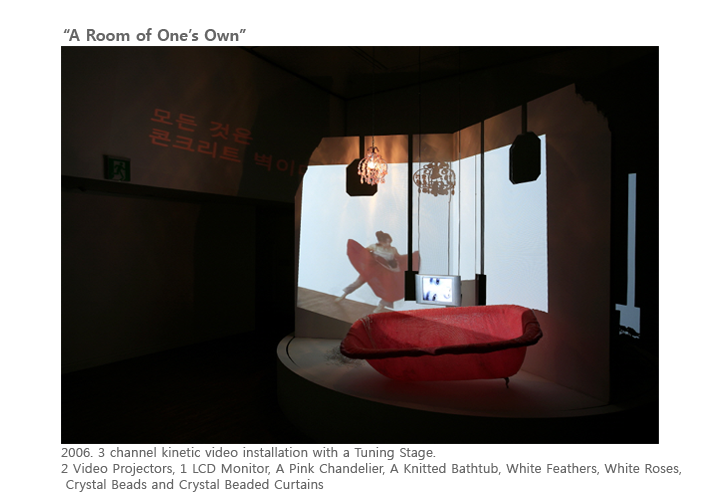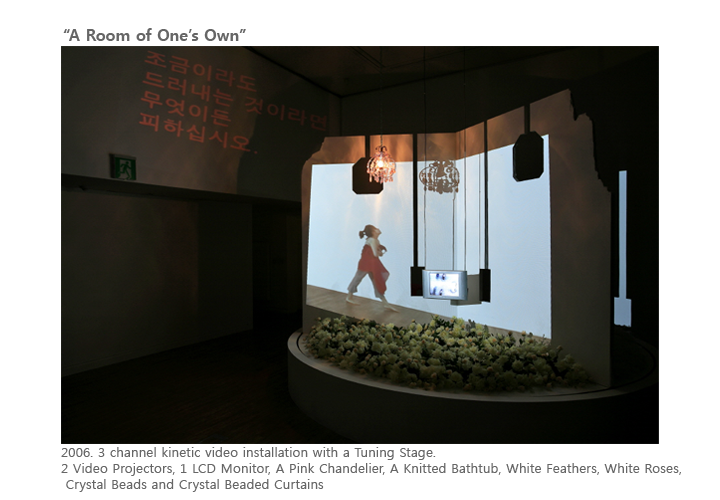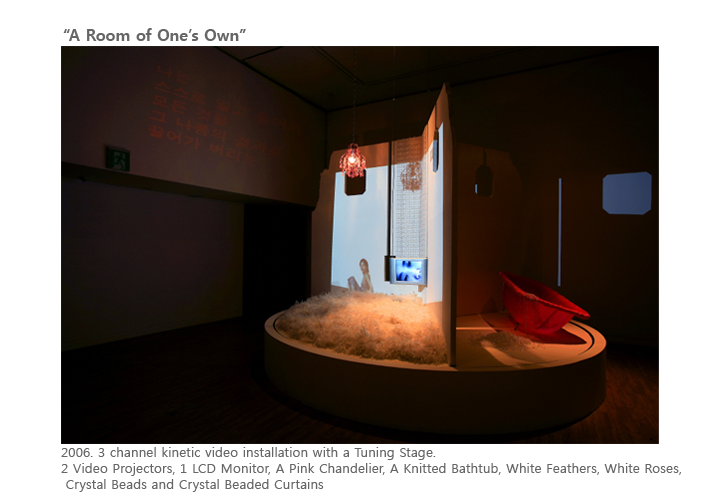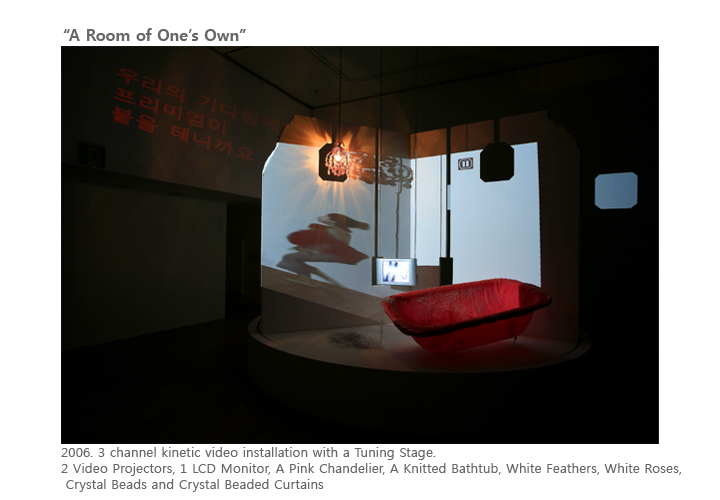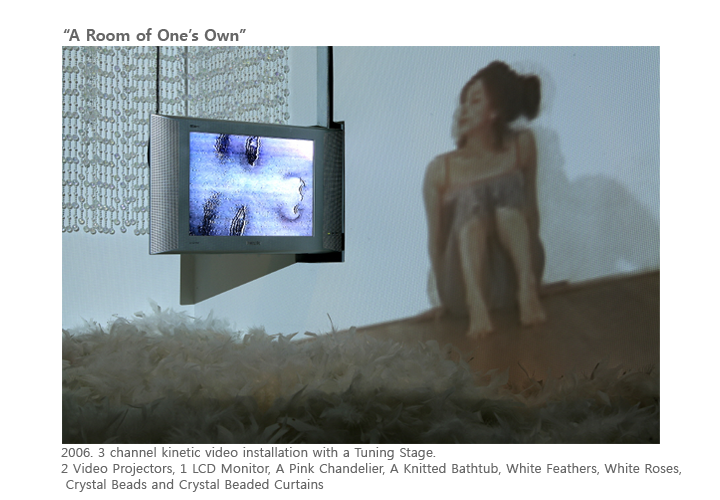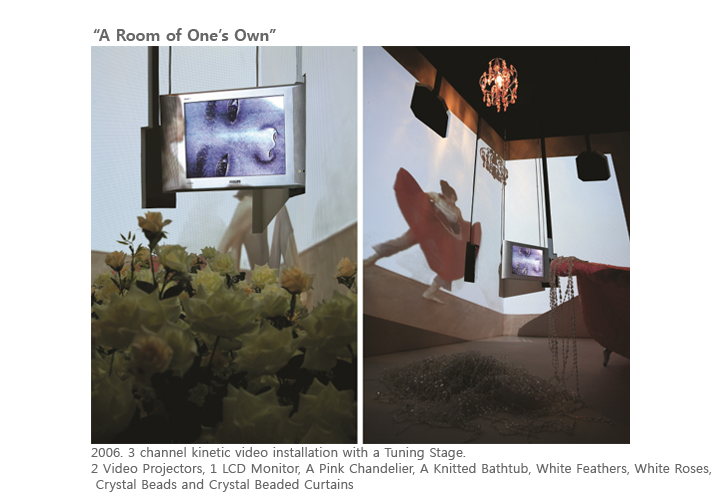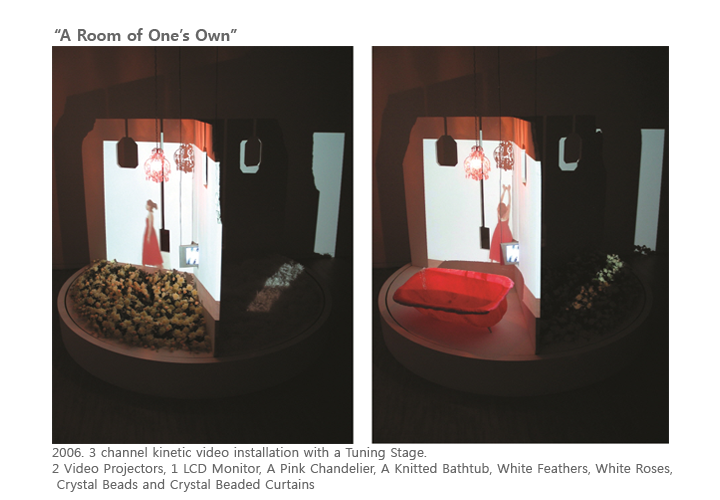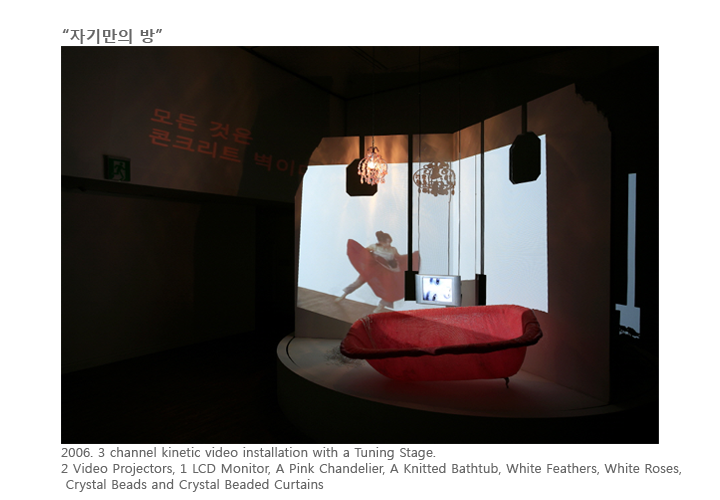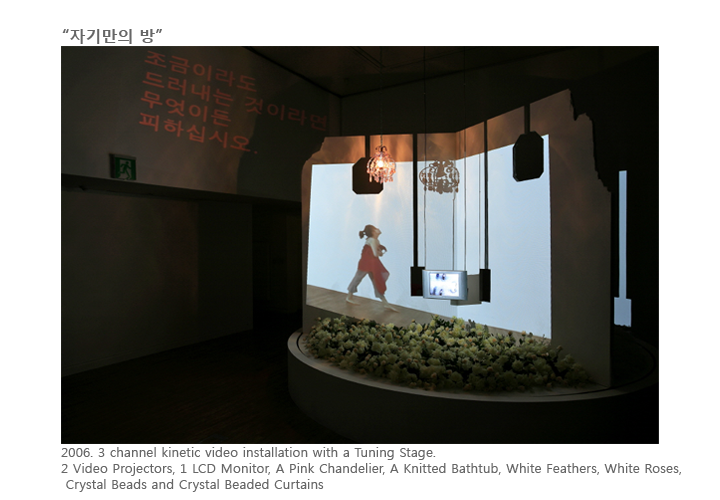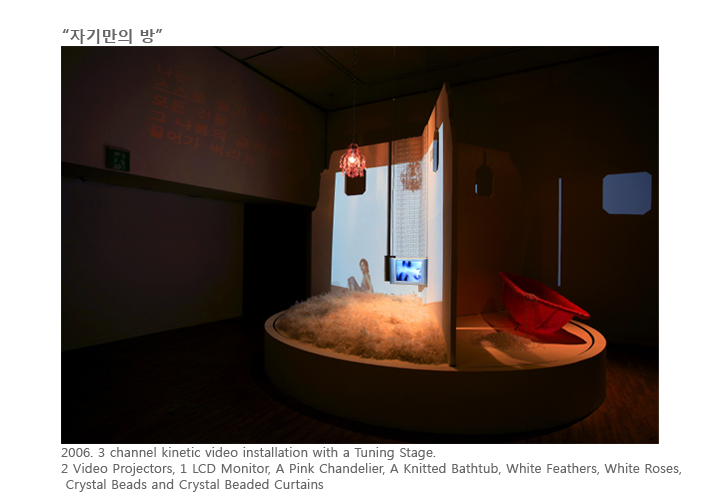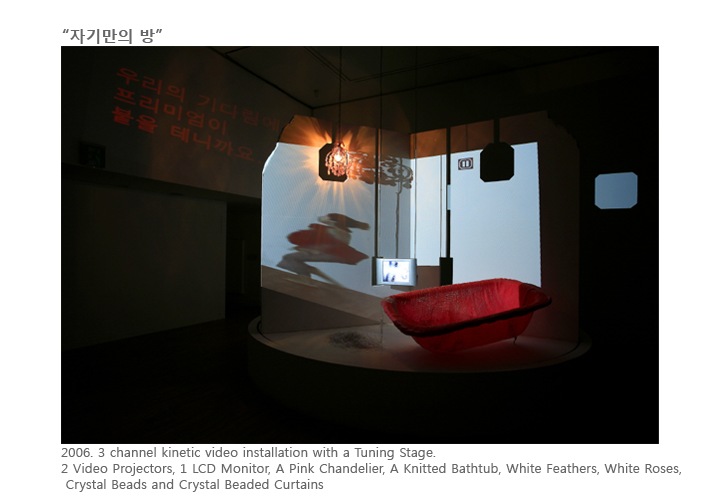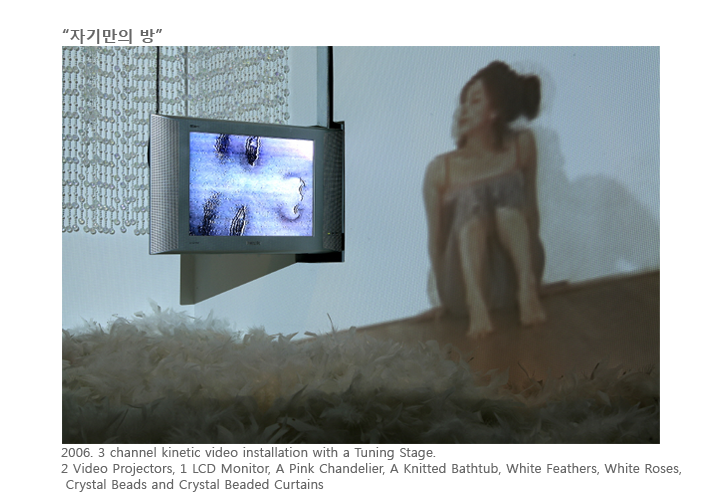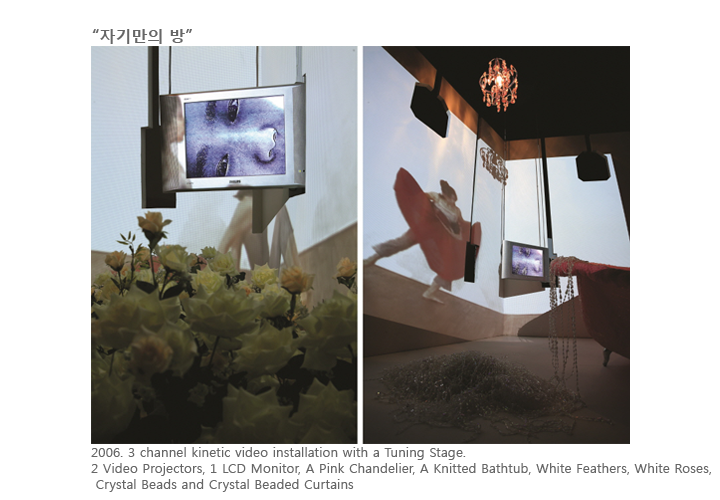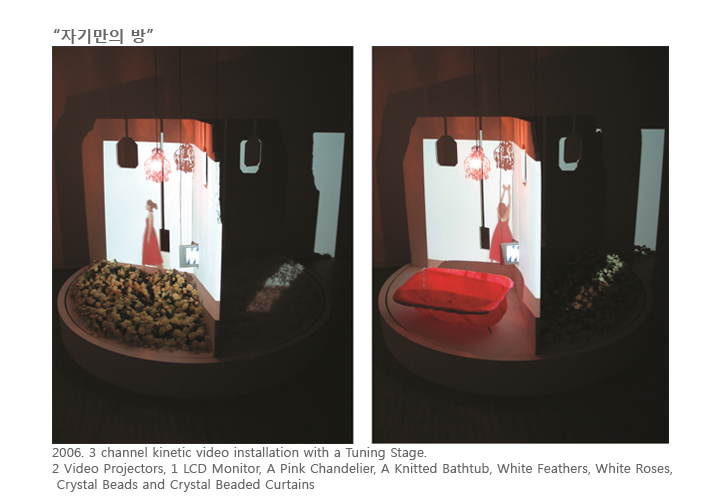
A system, whatever its structure, calls for us to intervene in the events of life. Of course, it doesn’t ask us to practice a specifically visible, concrete action. The system, however, is diversely in connection with the field of our consciousness, affecting people’s behavior. If its logic remains obscure, we go through the uncertainty of life along with some oppressive situations.
In “A Room of One’s Own” Jeong SoYoun demonstrates her belief that what she pursues as an artist presents the value of life and universality of our actions and cultures. Shown in the following she accepts as her main text is a quote from the writing of Virginia Woolf.
“Women not at all exist in history but their presence in a poem is consistently made from beginning to end.”
In this work the artist points out that women have been so far forgotten in history and portrayed as the object not the subject, arousing an awareness of their ontological rights. In this respect, Jeong transforms the matter of specificity as an individual into the justifiability or universality of woman’s life. Through artistic activities, she reveals the universality of life and embraces the value of aesthetic determination generating the forces of creative construction.
The revolving stage composed of three rooms is full of fragile items such as feathers, knitted bathtub, rose flowers, and so on. If viewed in the context of this work, they are more properly interpreted as the fleetingness of life rather than as the symbols of femininity. A female dancer and her performance are projected onto the wall of this stage. The dancer tirelessly moves right and left and puts on and off her outer garment repetitively. No narratives are found in her move. The movement is merely repeated endlessly, as does the revolving stage.
We become aware that the artist is in pursuit of the ontological truth of life, departing from clearly drawing a line between man and woman. What the artist seeks is ultimately the universal theme of recovering the essence and naturalness of life. On the one hand her “A Room of One’s Own” is a reference to something that could not be possessed and seen, but on the other it’s an extension of artistic attempts to emancipate her own self, pursuing progressively to attain dialectic self-awareness.
Jeong Yong-do (Art Critic)

가질 수 없는 것과 볼 수 없는 것
시스템은 그 구조가 어떤 것이든, 우리에게 삶의 사건들에 대한 개입과 순응을 요구한다. 물론 이런 것들이 가시적으로 우리에게 어떤 구체적인 행위를 요구하는 것은 아니다. 하지만 행위는 삶의 특성상 인간의 의식은 물론 무의식의 본질적인 영역과 관련되어 행위에 영향을 주게 된다. 그러므로 대부분의 경우 사건과 행위는 인과적인 관계를 가지게 된다. 이런 인과성은 삶과 예술의 역사는 물론 다양한 사회적 행위와 관련되어 여러 가지 방식으로 드러나게 되지만, 그러나 행위의 구조가 명확하지 않고, 시스템의 논리가 분명하지 않을 때, 우리는 삶의 불확실성과 더불어 부조리한 상황을 경험하게 된다. 정소연은 논리와 비논리의 미묘한 경계들에 대한 시각, 특히 여성들이 받아들여야 할 숙명적인 것들이라 생각되어 왔던 것들을 삶의 대상화된 역사, 혹은 물화된 윤리에 대한 논의의 문제로 제시한다.
그렇다고 해서 페미니즘적인 시각에서 다시 한번 구체적 행위의 영역을 이데올로기적으로 물화시키려는 시도를 한다는 것은 아니다. 정소연은 이번 <이미지 극장> 전시의 출품작 “자기만의 방”에서 영국의 여성 소설가 버지니아 울프의 동일제목의 자전적 성격의 소설 “자기만의 방”의 텍스트를 인용한다.
… 에 대한 셰익스피어의 견해
… 에 대한 버켄헤드 경의 견해
… 에 대한 잉 사제장의 견해
… 에 대한 라 브뤼예르의 견해
… 에 대한 존슨 박사의 견해
… 에 대한 오스카 브라우닝의 견해“
버지니아 울프가 거론한 인물들은 그녀 당시의 사회적 시스템을 구성하는 권위를 의미하는 상징적 인물들이다. 남성의 권위는 소위 역사 속에서 사회 시스템을 유지하기 위한 핵심적인 상황으로 작용해왔다. 여기서 작가가 스스로의 시각에서 바라보는 행위와 문화의 관계가 설정된다.
정소연의 시각은 시스템을 구성하는 견해에 대한 반론이 아니라, 삶의 진정한 개인적 특수성에 관련되는 행위의 보편성에 관한 것이다. 즉 자신의 미학적인 시각이 그동안 지배적인 구조로 작용해온 개념과 시스템들에 대한 반성적 기회가 될 수 있다는 태도인 것이다. ‘가질 수 없는 것’에 대한 반성적인 회한이 아니라, 작가로서 추구하게 되는 것들이 자연스러운 삶의 가치를 가질 수 있다는 것에 대한 믿음이 될 수 있다는 것이다. 다시 한 번 작가가 작품의 텍스트로 인용하고 있는 버지니아 울프의 구절을 보자.
“시에서는 첫 장에서 마지막 장까지
여성의 존재가 고루 퍼져 있지만
역사에서는
전혀 존재하지 않습니다.“
이 인용문에서 정소연은 여성의 존재성에 대한 의미의 문제를 거론하고 있다. 여기서 작가는 그동안 여성들의 존재가 인식되지 못한 역사, 대상으로는 존재하지만, 주체로서는 잊혀져왔던 삶의 내용들에 대한 존재론적 권리를 주장하고 있는 것이다. 단지 세상의 역사를 구성하는 적극적인 주체가 되지 못한다는 것에 대한 회한이 아니라 ‘볼 수 없는 것’에 대한 호기심과 궁금증에서 던지는 철학적 질문으로 생각할 수 있는 것이다. 가질 수 없기 때문에 가지려고 하는 것도 아니고, 보이지 않기 때문에 보려고 애쓰는 것이 아니라, 우리의 존재 혹은 나라는 존재가 가질 수 있는 정체성이 이런 방식으로 보여 질 수 있다는 가능성을 제시하는 것이다.
이런 면에서 정소연이 “자기만의 방”을 통해 보여주고자 하는 것은 보편적 개인으로서의 특수성에 대한 귀납적 보편성 혹은 여성의 삶의 당위성에 대한 것으로, 단순히 허상과 실상이라는 구분을 통해 이데올로기적인 대립성의 시각에서 여성의 삶을 역사적 현실에 비교하고자 하는 것은 아니다. 오히려 단순한 비교는 상황의 희화화를 가져올 수 있는 위험성이 크기 때문이다. 그래서 작가는 작품을 통해 좀 더 근원적인 존재의 문제를 생각해보는 것이다.
나는 스스로 밀고 들어와
모든 것을 그 나름의 결과로 끌어가 버리는
어떤 흐름을
의식하게 되었지요.
여기서 흐름은 버지니아 울프의 삶에서의 의식의 흐름과 관련되지만, 또한 정소연의 미술이 가지고 있는 의식의 영역에 대한 문제가 되는 것이다. 정소연이 가지고 있는 의식의 영역은 여성과 남성, 가정과 사회를 비교함으로써 획득된 것이 아니라, 그녀 자신의 예술적 시각을 통해 얻은 미학적 차원의 삶에 대한 순수성이다. 그동안 여성으로서 가질 수 없고, 볼 수 없었던 것들에 대한 가치 박탈 상황으로 부터의 자유에 대한 열망이 아니라, 삶의 근원적 존재성에 대한 물음을 통해 얻어지는 깨달음이라는 의미에서 자연스럽게 작가는 주체로서의 정당성을 지향할 수 있게 되는 것이다. 이것은 사회적 관계 항들의 진보에 대한 페미니즘적 기대도 아니고 삶을 구성하는 시스템들에 대한 혁명적 의지도도 아니다.
세 개의 방은 각각 깃털, 욕조, 장미꽃으로 채워져 있고, 회전무대에는 여성 무용수의 퍼포먼스가 투사된다. 무용수는 벽을 뒤로하고 끊임없이 좌우로 움직이고, 겉옷을 벗거나 입기를 반복한다. 무용수의 움직임에서 기승전결의 내러티브를 볼 수는 없다. 움직임은 회전무대와 같이 끝없이 연장적으로 반복될 뿐이다. 여기에 여성과 남성의 구분을 떠난 삶의 진실이 내재되어 있는 것이다. 탄생과 소멸, 의식과 무의식의 경계 같은 것들은 우리가 볼 수 있는 것도 아니고 소유할 수 있는 것도 아니다. 단지 삶과 함께 진행하고, 삶을 구성하며, 그 자체로 의미를 가질 수 있는 본질적인 것들로, 우리 행위의 지향성이 변증법적으로 투영되는 역동성과 같은 것들이다. 그러므로 삶의 자연스러움과 본질에 대한 시각적 반성이라는 면에서 정소연의 이번 작품 “자기만의 방”은 여성의 삶에서 “가질 수 없었던 것과 볼 수 없었던 것”들에 대한 적극적인 해석이라고 말 할 수 있는 것이다.
정용도(미술 비평)

